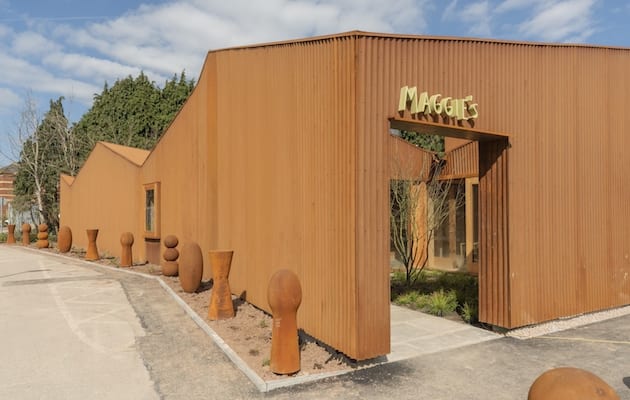 Maggie’s South East Wales Centre|||
Maggie’s South East Wales Centre|||
Dow Jones Architects’ design for a temporary Maggie’s South East Wales Centre, situated in the grounds of the Velindre Cancer Centre in Whitchurch, North West Cardiff, recalls the natural beauty of the surrounding Welsh mountains.
 The exterior features a weathering steel facade
The exterior features a weathering steel facade
 Maggie’s South East Wales Centre exterior
Maggie’s South East Wales Centre exterior
The London-based practice was commissioned to create a centre for Velindre back in 2011. That scheme was funded and received planning permission in 2014 but the hospital masterplan was then revised for a different site and updated to cater to a significantly longer programme.
 Maggie’s South East Wales Centre interior
Maggie’s South East Wales Centre interior
 Maggie’s South East Wales Centre interior
Maggie’s South East Wales Centre interior
Following years spent in planning limbo, Maggie’s felt that an interim centre should be delivered to provide support to patients at Velindre until the larger hospital development is completed.
 Maggie’s South East Wales Centre internal courtyard
Maggie’s South East Wales Centre internal courtyard
 Maggie’s South East Wales Centre interior
Maggie’s South East Wales Centre interior
Dow Jones’ response to the Maggie’s brief is, therefore, a makeshift centre intended to be used for ten years but could be used indefinitely.
 Maggie’s South East Wales Centre interior
Maggie’s South East Wales Centre interior
With its undulating form, comprised by a series of pitched roofs, the facility stands as an architectural manifestation of the emotional, physical and spiritual ups and downs one experiences when undergoing treatment for cancer. The building cuts a striking silhouette against the local Welsh vernacular.
 Maggie’s South East Wales Centre interior
Maggie’s South East Wales Centre interior
This, along with Dow Jones’ choice of weathering steel for the façade, communicate that the centre is a place of warmth, comfort and healing. These warm hues spill over into the interior, where rich Douglas fir elements are also used to subdivide the main spaces.
Read more about why designers should make better use of the healing powers of colour
 Maggie’s South East Wales Centre interior – kitchen and dining area
Maggie’s South East Wales Centre interior – kitchen and dining area
The idea of Maggie’s Centres came from Maggie Keswick Jencks, the wife of architecture critic Charles Jencks, who believed good buildings could change the way people felt. Each centre is therefore designed as a place to care for, but not treat, people with cancer. The first centre was established in Edinburgh in 1996, designed by Richard Murphy and nominated for the Stirling Prize.
The collection of centres now numbers more than 17 across the UK and Hong Kong, designed by some of the world’s biggest architects, including Frank Gehry, Foster + Partners and WilkinsonEyre among them.
See inside the interim Maggie’s Centre, finally opening to local residents



























